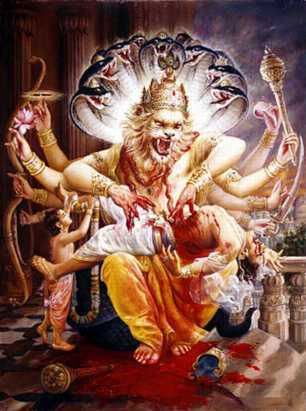Contributed By: Rajalakshmi SrinivasaGopalan
The Karma that a garbhavati does will have a magnifying effect on the baby. As a negative example of this, we saw Valmiki maharshi’s story. The positive example is that of Prahlaada, the putra of Hiranyakashipa and Leelaavati:
When Prahlaada was in the garbham of Leelaavati, his pita, Hiranyakashipa did a severe Tapas for Brahmadeva. Hence Leelaavati had the adrushtam of staying in the pivitra aashramam of Naarada maharshi. Due to the tapashshakti of Naarada, snakes-vultures, lions-elephants and other such animal pairs which have natural enemity, left their anger on one another and were co-existing in peace. Because of living in such an environment, Leelaavati used to always think about good and used to listen to the puraanams told by Naarada maharshi.
One day, when Naarada maharshi was describing Shri Hari Leelas and greatness of Hari-bhakti, Leelaavati slept off, but Prahlaada who was in her garbham was listening a telling “ok” “ok” to all the tattvam that Naarada maharshi was telling. Thus even before Prahlaada was born he got Gnyaanopadesham from Naarada maharshi. On one shubha-lagnam, Prahlaada was born. Devatas showered pushpa-varsham.
Brahmadeva, who was impressed by the severe Tapas of Hiranyakashipa, appeared before him and said “Vatsa! Your tapas is advitiiyam. Ask Me your abhiishtam and i will grant it”. Hiranyakashipa had duraasha. He believed this shariiram is shaashvatam and satisfying physical senses itself is aanandam. Hence he asked Brahmadeva “Svaami! I must have no maranam (death)”. Brahmadeva said “Kumaara! This is against Shrushti-niyamam. Ask any other varam”. Hiranyakashipa asked “Either on land, in water, in fire, in air, in aakaasham, by animals or humans or deva-daanavas or yaksha or kinnera or siddha or vidyaashara adi praanis, by any shastra-astras, during day or night I must never get maranam. Also I must always have vijayam in yuddham, I must get more power than Indra aadi loka-paalakas and be the King of Tribhuvanams”. Brahmadeva replied “Kashyapa-putra! no one ever asked such varams previously. But since you have done tapas and impressed Me, I am granting you this varam. But be a buddhi-sampanna and live”.
Even though Hiranyakashipa was putra of the great Kashyapa maharshi and had great tapashshakti, he got ahankaaram because of the varam he got from Brahmadeva. He, with his vara-gravam, forgot that Brahmadeva said “be a buddhi-sampanna and live”, and started to torture worlds, saadhu-sajjanas, pativratas. Who can save a fly that gets attracted to fire and gets burnt? He started saying he is only God, everyone should pray to him and do pooja to him. His paapam was increasing day-by-day and finally by torturing his own child, Prahlaada, who was a great Shri Hari bhakta, he himself became the cause for his death:
Hiranyakashipa tried to torture Prahlaada by throwing him down cliffs, getting him stamped by elephants, burning him in fire etc., but nothing happened to the great Hari bhakta. Prahlaada, who had only Shri Hari in his mind, never even thought about anything else. Hence Shri Hari saved him from the tortures of Hiranyakashipa.


One day at Sandhya-samayam, fed up with Prahlaada saying Shri Hari is only Paramaatma, His bhakti is only shaashvatam, Hiranyakashipa said “where is your Hari? I even went to Vaikuntham and searched for him to kill him, but he was not there. There is no Hari. I am only Bhagavaan”. Prahlaada replied “Dont have the doubt that He is here, He is there. He is everyone. Wherever you search for Him with Bhakti, He will be there”. Then with anger Hiranyakashipa said “is it? If so, show Him to Me in this pillar”. Then Mahaavishnu appeared from the pillar in the form of Nara-simham, placed Hiranyakashipa in His lap, and teared him into pieces using His nakhas (nails).

Thus even though Hiranyakashipa asked for a varam so that it was difficult to kill him, he forgot the fact that Paramaatma is more powerful and his duraasha, ahankaaram only lead to his downfall.

Morals in the Story:
- A garbhavati’s other name is dauhrudi (one who has two hrudayams). According to our shaastras, whatever a garbhavati does has magnifying effects on the child. Hence our shaastras recommend, atleast during that period, listening to Harikathas, Puraanams etc. and always think good. Since Leelaavati did all these, her son Prahlaada became a great Hari-bhakata and a Dharmaatma.
- Duraasha always leads to difficulties (see Prataapabhaanu’s story). Hiranyakashipa, with his duraasha, believed this shariiram is shaashvatam and asked for a varam which no one else asked. Brahmadeva also said if he is good and has sadbuddhi then the varam will be of use. But having vara-garvam he tortured the worlds and himself became a reason for his end.
- The Bhakti of Prahlaada is ananyam. Though he was kid and his father tortured him so much, he never thought about anything other than Shri Hari. Hence Mahaavishnu saved him. Prahlaada comes first in the list of Bhaktas and is a maarga-darshi for us.
Search Terms: Prahlada, Haranykasipa, Narada, Lilavati, Lilavathi, Leelavathi, Leelavati.





